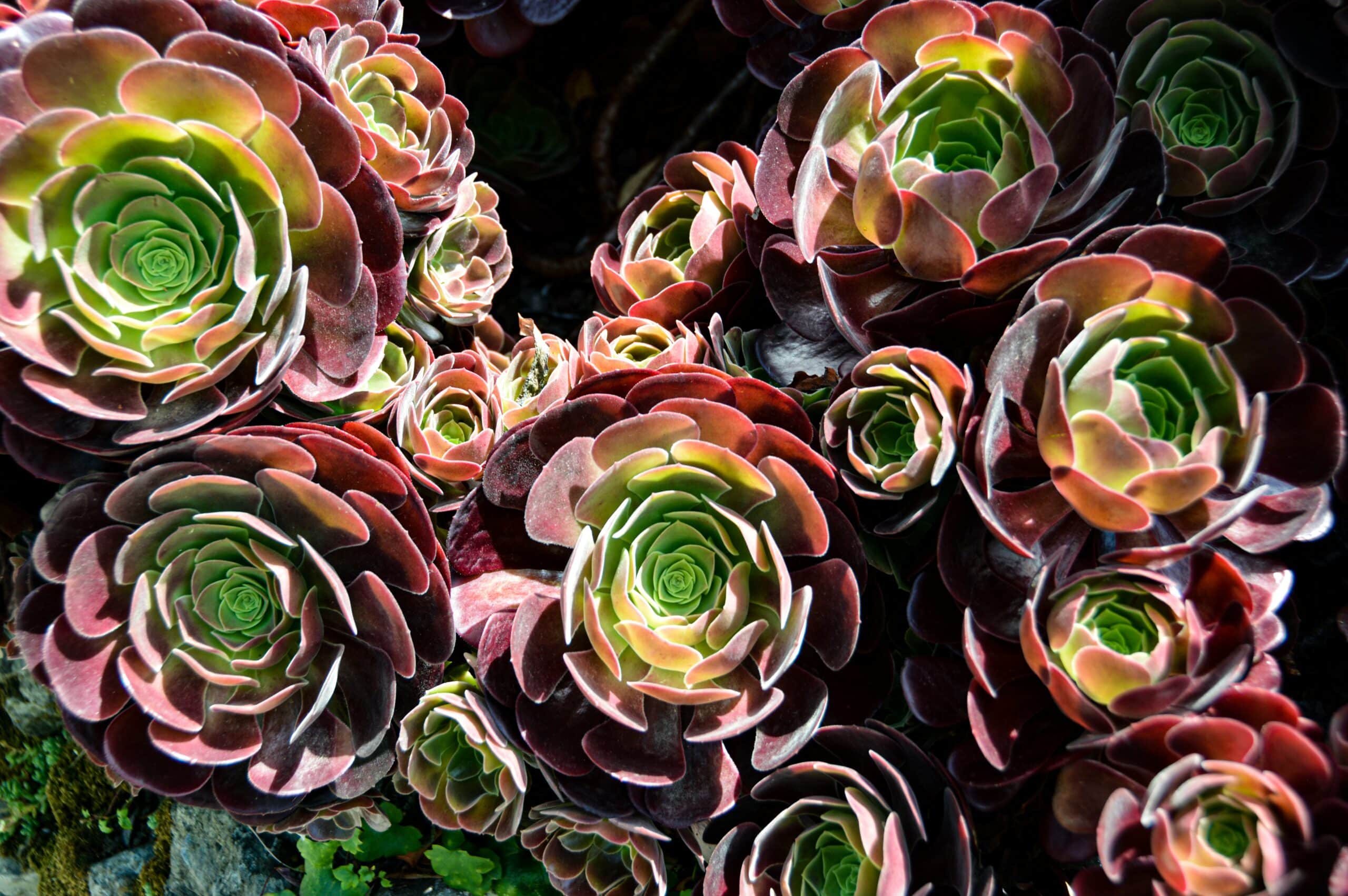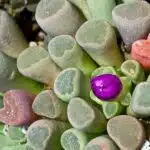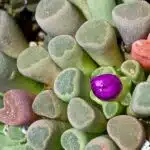Aeoniums are a unique type of succulent that have an almost alien-like appearance. From their out-of-this-world look to their ability to thrive in even the harshest of climates, Aeonium plants are an exotic and beautiful addition to any garden or home. But while they may appear easy to care for, Aeonium plants require specific attention and knowledge in order to thrive.
The contradictory nature of Aeonium plants makes them both a challenge and a joy for those who take on the responsibility of caring for them. On one hand, they require minimal maintenance such as watering, pruning, and repotting in order to stay healthy and vibrant. On the other hand, if not cared for properly, these plants can become stressed and die quickly.
Learning how to properly care for Aeoniums is essential in order to ensure that your plant is healthy and happy. In this article we will provide you with all the necessary information you need on how to properly care for your Aeonium plant so that it will be able to grow and bloom into its fullest potential. Keep reading to learn more about proper plant care and growing techniques for this unique succulent!
Types Of Aeonium
Aeoniums are a diverse group of succulent plants that come in a variety of shapes, sizes, and colors. For those looking for something unique to add to their indoor or outdoor garden, Aeoniums may be the perfect choice. With over 40 species available, there’s sure to be one that fits the look you’re going for.
Aeoniums can range from small rosettes with leaves less than an inch long, to larger rosettes up to 18 inches across. They can have solid green leaves or variegated red and yellow ones, depending on the species. Some even produce flowers in hues of yellow or pink!
No matter your preference, Aeoniums provide a low-maintenance and visually stunning addition to any garden. With such a wide selection of types to choose from, you’re sure to find the perfect specimen for your space. Now let’s take a look at what it takes to keep these beauties thriving in their environment.
Growing Conditions For Aeonium
Growing aeonium is like solving a jigsaw puzzle: it requires the right pieces to fit together perfectly. When growing aeonium, there are numerous conditions to keep in mind so that your succulent can thrive. To give your plant the best chance of success, it’s important to understand these conditions and provide them for your aeonium.
When growing aeonium, light and temperature are two of the most important factors to consider. Aeonium prefers bright, indirect sunlight or partial shade. If you live in an area with high summer temperatures, it’s important to protect your plant from intense direct sun exposure during this time of year. Additionally, aeonium should be kept at temperatures between 50-85 degrees Fahrenheit; anything higher or lower could cause damage to the plant.
Watering is another essential factor when caring for aeonium; too much water can lead to root rot while not enough can cause leaf drop and wilting of the stems. Water only when soil is dry and reduce watering further during winter months when growth slows down considerably. Providing air circulation and humidity around the succulent will also help keep it healthy; be sure to avoid letting any water accumulate in its rosettes as this can cause fungal disease and root rot.
To ensure success with growing aeonium, it’s important to provide proper light and temperature conditions as well as adequate water – following these guidelines will help you achieve optimal results with your succulent plants!
Planting Aeonium Outdoors
It’s a coincidence that you are looking for information about planting Aeonium outdoors – one of the best ways to bring this beautiful succulent into your garden. Planting Aeonium outdoors is not as difficult as it may seem, but there are some important factors to consider before doing so.
First, make sure that the region where you intend to plant the Aeonium has gentle winter temperatures and plenty of sun throughout the year. This succulent prefers warm climates with full sun and well-drained soil. If your area gets cold during winter, be sure to choose a protected location or use mulch around the base of the plant to help protect it from freezing temperatures.
Aeonium needs plenty of water during its growing season, but be careful not to over water it as this succulent can easily rot due to too much moisture. Monitor the soil regularly; if it’s dry an inch below the surface, then it’s time to give it a good soak. As always, healthy drainage is essential for successful outdoor planting. Make sure that you provide adequate drainage by adding organic matter such as compost or peat moss when preparing your beds for Aeonium plants.
Now you know how to successfully plant Aeonium outdoors in your garden! With proper care and attention, these colorful succulents can add life and texture to any landscape or container garden – just remember not to overwater them! The next step in caring for Aeonium is learning how to transplant them into containers...
Planting Aeonium In Containers
When it comes to adding aeonium to your garden or patio, planting in containers is a great way to go. Containers provide the perfect environment for this slow-growing succulent, allowing you to control the soil, water, and sunlight it receives. Plus, they add an interesting aesthetic to any outdoor space.
Before you get started, make sure your container has plenty of drainage holes in the bottom and that it’s large enough for the mature size of your plant. Then fill it with cactus/succulent potting soil mixed with gravel or sand. Planting should be done with care; each stem should be separated from the main cluster and planted at least 2-3 inches apart to ensure proper growth.
Once planted in its new home, aeonium needs regular waterings until its root system is established (usually 3-4 weeks). After that, water only when the top inch of soil has dried out – too much moisture can cause root rot. With just a little TLC and attention, you’ll have an attractive addition to your garden or patio that’s easy and low maintenance. Now let’s talk about water requirements for aeonium next…
Water Requirements For Aeonium
Watering Aeonium is essential for its health and vitality. It’s important to keep the soil evenly moist, but not soggy. Additionally, there must be adequate drainage in order to prevent root rot.
Watering frequency will depend on several factors such as pot size, type of soil and climate conditions. Smaller pots tend to dry out faster than larger ones, so they may require more frequent watering. In hot weather, plants may need to be watered every day while in cooler temperatures they may only need water once or twice a week.
The best way to determine if your Aeonium needs watering is by feeling the soil with your finger. If it feels dry an inch below the surface, then it’s time to water. Overwatering can cause root rot and other diseases that can kill your plant, so it’s important to keep a close eye on how much water you give it.
Aeonium requires regular watering for optimal growth and health – but knowing exactly when and how much water is needed can be tricky! With careful observation and attention to detail, you can ensure that your Aeonium receives the perfect amount of hydration for successful growth and blooming. Now let us move on to discussing light requirements for Aeonium plants!
Light Requirements For Aeonium
The care for Aeonium plants can be tricky, but understanding their light requirements is key. In this section we’ll discuss what type of lighting Aeoniums need to thrive and how much sun exposure they should receive.
When it comes to light, Aeoniums prefer bright, indirect sunlight. Direct sunlight can cause the leaves to burn, so it’s best to avoid direct sunlight in the summer months. To ensure that your plant gets enough light during the winter months, you can move it closer to a window or porch. When the days are shorter and darker in winter, supplementing with a grow light is recommended.
Although they do best in bright, indirect sunlight, Aeoniums can also tolerate low-light conditions if necessary. If you’re unable to provide them with sufficient light indoors or outdoors, consider getting an artificial plant light that will help simulate natural sunlight and allow them to survive in low-light environments. With proper care and attention, your Aeonium will thrive no matter where you place it!
Providing your Aeonium with the right amount of light is important for its health and growth. Now that you know how much sun exposure they need and what type of lighting is best for them, let’s talk about feeding your Aeonium for optimal growth and vitality…
Feeding Aeonium
Aeoniums are beautiful plants that can bring life to any home. Surprisingly, they are also easy to care for. Feeding is one of the most important aspects of caring for your aeoniums and should be done regularly.
To get the most out of the nutrition your aeoniums need, you should use a balanced fertilizer that is specifically made for succulent plants. A good rule of thumb is to apply fertilizer once every two weeks during the growing season and once every four weeks in the winter months. You can mix the fertilizer with water and use it as a spray or pour it directly onto the soil around your plant.
When it comes to feeding your aeoniums, moderation is key. Too much fertilizer can cause root burn which could lead to an unhealthy plant or even death. Instead, give them just enough nutrients to keep them healthy and thriving without overfeeding them. Additionally, if you notice any signs of nutrient burn on your plants, cut back on feeding them until they recover from the damage.
It’s also important to remember that proper drainage is essential when caring for your aeoniums and will help prevent root rot caused by too much water or fertilizer in their soil. With these simple tips, you’ll be able to give your aeoniums all of the nutrients they need while avoiding any potential problems from overfeeding them!
Temperature Requirements For Aeonium
When it comes to temperature requirements for aeonium, there are a few things you should keep in mind. Different varieties of plants may require different temperatures, so be sure to check the label before making any decisions. To ensure your aeonium thrives and grows robustly, here’s what you need to know:
• Aeonium prefer average household temperatures between 65-75 degrees Fahrenheit. They can tolerate cooler temperatures for short periods of time, but prolonged exposure to lower temps can create stress for the plant, reducing growth and flowering potential.
• If possible, avoid placing your aeonium near hot vents or windowsills that receive direct sunlight as this could dry out the foliage and cause leaf discoloration.
• In winter months when temperatures dip below 50 degrees Fahrenheit, you may need to bring your aeonium indoors or provide extra protection from cold drafts.
By following these three guidelines when it comes to temperature requirements for your aeonium, you will help ensure its health and vitality. Now that we’ve discussed temperature let’s take a look at pruning aeonium. Pruning is an essential part of maintaining healthy growth in your plants…
Pruning Aeonium
When it comes to pruning aeonium plants, the key is to know when to cut them back and how much. Surprisingly, these succulent plants need regular pruning in order to stay healthy and bloom. About every 5 weeks, it’s necessary to prune off any dead or yellowing leaves and stems so that new ones can grow in their place.
When you’re ready to start pruning, it’s important to use very sharp scissors or shears so you can make clean cuts without damaging the plant’s tissue. Start by cutting off dead leaves at the base of the stem, then working your way up while removing any brown or yellowed foliage. It’s also essential to pay attention to the overall shape of your aeonium—prune away any branches that are overgrown or out of proportion with the rest of your plant.
Once you’ve finished pruning your aeonium, be sure to apply a balanced fertilizer for succulents every few weeks during the growing season. This will help replenish any nutrients that may have been lost during the trimming process and ensure your plant thrives for years to come!
Propagating Aeonium
Propagating aeonium plants packs potential for plenty of progress and promises plenty of pleasure. Plant propagation is a practical pursuit that provides proficient potted plant producers with plentiful possibilities to pursue. There are numerous methods for multiplying and magnifying your aeonium collection, from stem, leaf and root cuttings to layering techniques, division and more.
Simply severing stems or leaves from the parent plant is an easy way to start propagating aeoniums at home. Much like any other succulent, cut the stem off close to the base at an angle using sharp scissors or pruning shears and let it dry out where air can get to it before planting in a well-draining soil mix. The same procedure applies when taking leaf cuttings; gently twist off the leaves near the stem and allow them to dry out before planting in sandy soil.
Root cuttings are another popular form of propagating aeoniums. Carefully dig up the root ball of the parent plant and slice off some sections as long as four inches – just make sure each section has several sets of roots on them. Then bury them into pots filled with potting mix or sand, water lightly and keep in bright light until new growth appears from the base of the cutting.
Having successfully multiplied your aeoniums through propagation, you’ll need to be mindful about common pests and diseases which could potentially harm your plants if not addressed quickly.
Common Aeonium Pests And Diseases
Like any other plant, Aeoniums are susceptible to pests and diseases. Unfortunately, there are many potential problems that can affect your Aeoniums, so it’s important to be aware of them. In this section, we’ll look at the common pests and diseases that can plague Aeonium plants.
The most common pests that affect Aeoniums include aphids, mealybugs, spider mites, and scale insects. These pests feed on the sap of the plant and can cause damage to the leaves and stalks. While these pests can be difficult to get rid of, there are several methods you can use to control them. The easiest way is by physically removing the pests from the plant with a cotton swab or tweezers. You can also spray neem oil or insecticidal soap on the plant to kill off any remaining bugs.
In addition to pests, Aeoniums are also vulnerable to fungal diseases such as powdery mildew or leaf spot. These fungi thrive in damp conditions and cause discoloration and stunted growth of the leaves. To prevent these diseases from occurring in your plants, make sure they’re not kept in overly humid environments and ensure they get plenty of air circulation around them. If you do notice signs of disease on your plants, try treating them with a fungicide as soon as possible to stop it from spreading further.
By taking preventive measures against common pests and diseases, you can help keep your Aeoniums healthy and happy for years to come! With proper care and monitoring, controlling pests and diseases should be relatively straightforward – just remember to act quickly if you notice anything suspicious!
Controlling Pests And Diseases Of Aeonium
Controlling pests and diseases of aeonium is essential for having healthy plants. This section will cover the steps you can take to protect your aeonium from common problems.
First, it’s important to be aware of the risks that can affect aeoniums. Common pests include aphids, mites, mealybugs, scale insects, and thrips. Diseases like powdery mildew and botrytis blight can also cause problems.
Fortunately, there are ways to minimize the risk of pests and diseases affecting your aeoniums. Here are three tips that can help:
- Inspect your plants regularly for signs of pests or disease – this way you can catch any problems early on
- Make sure you provide your plants with adequate air circulation by pruning back overgrown branches
- Keep the soil moist but not wet – overwatering can create an ideal environment for fungus and other diseases
By following these steps, you should be able to keep your aeoniums healthy and pest-free. With proper care and maintenance, you’ll be able to enjoy them for many years to come. Now let’s look at how we can ensure our aeoniums grow in the best conditions possible.
Tips For Growing Healthy Aeonium
Aeonium is a symbol of renewal and rejuvenation, a reminder that despite the challenges life throws at us, it is possible to thrive. From its vibrant flowers to its evergreen leaves, this succulent offers a feast for the senses. With proper care and attention, growing healthy Aeonium can be easy and incredibly rewarding.
When growing Aeonium plants, ensuring proper drainage is key. Plant in well-draining soil that has been amended with sand or perlite for optimal drainage. Water deeply but infrequently; allowing the soil to dry out between waterings will help prevent root rot. In addition, provide adequate sunlight for your plants, but avoid prolonged direct sun which can scorch the leaves.
Finally, controlling pests and diseases is essential for healthy Aeonium plants. Inspect your plant regularly for signs of insects or disease and take appropriate action if necessary. Pruning will also help keep your plant healthy by removing dead leaves or stems that may have become diseased. With these tips in mind, you’ll be sure to have happy and healthy Aeonium plants!
Uses For Aeonium
What a coincidence! We were just talking about growing healthy aeonium and now we’re discussing uses for it. It’s almost like the plant itself is guiding us forward!
Aeonium is an incredibly versatile plant. From its elegant, sculptural leaves to its eye-catching colors, it adds beauty wherever it goes. It also provides health benefits for its keepers. The leaves are full of antioxidants and vitamins, making them a great addition to salads or smoothies. Plus, they can make gorgeous flower arrangements when paired with other blooms.
But the uses don’t stop there: Aeonium can even be used as an ornamental decoration in your home or garden! If you’re looking to spruce up a space without spending a fortune, it’s worth considering how this unique plant can add texture and color to your environment. So whether you want to beautify your living room or create an interesting focal point in your garden, Aeonium may be just the ticket!
Now that we’ve explored all the wonderful ways to use Aeonium, let’s take a look at troubleshooting problems with this beautiful plant.
Troubleshooting Problems With Aeonium
It’s true that aeoniums are usually easy to care for and maintain, but there might come a time when you experience some issues with your plant. While it can be disheartening, understanding how to troubleshoot these problems can help ensure your plant remains healthy and happy. Let’s explore the potential issues you might encounter with aeoniums, and how to resolve them.
One potential issue is that the tips of the leaves may curl up or dry out due to inadequate light exposure. To remedy this problem, make sure your aeonium gets at least four hours of direct sunlight each day. If necessary, you can even move it closer to the window where it will receive more light.
Another common issue is underwatering or overwatering – both can have detrimental effects on your plant if left unaddressed. If you’ve been underwatering your aeonium, simply increase the frequency of watering and watch as it slowly recovers its health over time. On the other hand, if you’ve been overwatering, reduce the amount of water given until it starts looking better again.
Whatever issues crop up with your aeoniums, remember that troubleshooting them is often relatively simple – as long as you’re willing to pay attention to what your plant needs and act accordingly! With just a few minor adjustments in care practices here and there, you’ll find that keeping an aeonium healthy isn’t difficult at all.
Frequently Asked Questions
How Often Should I Water Aeonium Plants?
Watering an Aeonium plant can be a tricky task. Too much water and it may not survive, too little and it won’t thrive. Fortunately, there are some simple guidelines to follow that will help you keep your Aeonium healthy and happy.
First and foremost, you should water your Aeonium when the top of the soil is dry to the touch. Depending on the environment in which your plant is located, this could be anywhere from once every two weeks to once per week. To ensure you don’t overwater your Aeonium, always check that the soil is dry before adding any more water:
• Feel the top layer of soil with your fingers – if it’s dry, add water • Avoid leaving standing water around the roots • Water until excess moisture runs out of the drainage holes in the bottom of the pot
When watering an Aeonium, it’s best to use room temperature or lukewarm water; very cold or hot water can shock its delicate system. If you have hard water (high mineral content) consider either using distilled or filtered water instead as minerals can build up in the soil over time and cause issues for your plant.
It’s also important to keep an eye out for signs that something might be off with your Aeonium – drooping leaves or yellowing foliage are often indicative of dehydration or overwatering respectively. Taking proactive steps like these will help ensure that your plant stays healthy and continues to thrive!
What Is The Best Soil Type For Aeonium?
The right soil type can be the difference between a thriving aeonium and one that struggles to survive. Like any other succulent, this plant needs an environment where its roots can take in enough water without drowning. So, what is the best soil for aeonium?
If you want your aeonium to reach its full potential, it’s best to use a cactus potting mix. This type of soil will provide the drainage it needs while also giving it access to essential nutrients. It’s also important to make sure that the mix you use is coarse and contains some organic matter like peat moss, perlite, or vermiculite. These components improve air circulation and prevent water from pooling at the bottom of the pot.
To ensure that your aeonium has the best chance of success, make sure to amend your soil with compost or fertilizer every few months. This will provide additional nutrition and encourage healthy growth. With the right soil type in place and regular feeding, you’ll have an attractive houseplant that will bring life into any space!
Can I Grow Aeonium Indoors?
Are you desperate to bring a bit of life into your home? Then you should consider growing Aeonium! It is an incredibly beautiful and easy-to-care-for succulent, perfect for any indoor space. Growing Aeonium indoors is a breeze – it’s almost too good to be true!
Before you can get started, there’s one important step to consider: soil type. You don’t want just any old soil; for your Aeonium to thrive, it needs the right kind. Lucky for you, finding the best soil type isn’t as hard as you might think!
Aeoniums love light and well-draining soil that won’t retain too much water. To achieve this balance, combine equal parts potting mix and coarse sand or perlite – this mixture will help the plant absorb moisture without sitting in wet soil. Once the mix is prepared, you can start planting your Aeonium with glee! Just make sure to keep it in a sunny spot and maintain regular watering, and watch it come alive with vibrant greenery.
You’re now ready to experience all the beauty Aeonium has to offer – its spectacular clusters of rosettes will fill your home with color like nothing else. So don’t wait – get ready to bring some natural wonder inside today!
How Do I Know When Aeonium Need To Be Re-Potted?
Like a puzzle that needs to be solved, understanding when to re-pot your aeonium can be tricky. Figuratively speaking, the key is to pay attention to the telltale signs that your plant may need a new home. Sure, it takes some extra effort but with the right know-how, you’ll be able to keep your aeonium healthy and happy for years to come.
The most obvious indication that your plant needs re-potting is if there’s visible roots coming out of the drainage holes at the bottom of the pot. This means that your aeonium has outgrown its current home and requires more room in order to spread its roots and continue thriving. Another indicator is if you notice discoloration in areas of the leaves or stems; this could mean that there isn’t enough nutrition in the soil and it needs replenishing through repotting.
Taking care of an Aeonium doesn’t have to be complicated. With some patience, vigilance, and an eye for detail, you can make sure your beloved plant gets all the TLC it deserves. If you take note of these warning signs and act accordingly, you’ll be able to provide your aeonium with an optimal environment so it can flourish for years to come!
What Is The Best Fertilizer For Aeonium?
Fertilizing aeonium plants can be crucial for their health and growth. It’s estimated that about 80% of all houseplants require some kind of fertilizer to remain vibrant and healthy. Aeonium is no exception — it needs the right nutrients to stay strong and colorful. But what is the best fertilizer for aeonium?
When it comes to fertilizing aeonium, slow-release granular fertilizers are the way to go. They provide all the necessary nutrition that aeonium need — nitrogen, phosphorus, and potassium — over an extended period of time. This type of fertilizer also minimizes stress on the plant since they’re not getting too much or too little at any given time. Plus, they’ll last longer than liquid fertilizers in terms of providing nutrition.
Slow-release granular fertilizers will provide your aeonium with all the essential nutrients they need to thrive without burning or stressing them out. If you have an aeonium plant, make sure you give it some love and nourishment with the right kind of fertilizer!
Conclusion
Aeonium plants are a stunning addition to any garden. With the right soil, water, and fertilizer, these plants can provide years of lush growth and dramatic foliage. When cared for properly, Aeoniums are sure to turn heads with their vibrant beauty and unique shape.
Watering Aeoniums correctly is key to keeping them healthy and happy. Water just enough so that the soil stays moist but not soggy. Provide well-draining soil, as too much moisture can cause root rot and other issues. Fertilize regularly, especially during the growing season, to ensure your Aeoniums receive all the essential nutrients they need to thrive; doing so will be like pouring liquid gold on your plants!
Caring for your Aeoniums is a labor of love that’s sure to be rewarded. With minimal effort and maintenance you can have a garden filled with these gorgeous succulents in no time – their beauty is simply staggering! By following these simple tips you will be able to create an eye-catching oasis full of color and life that will leave you absolutely speechless – it’s almost like having a piece of heaven in your backyard!





























